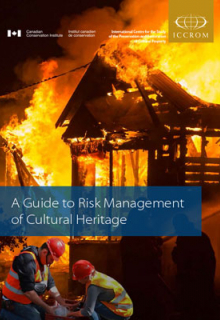Two new online publications by ICCROM and CCI
In today’s world, cultural heritage institutions must strive to be accountable, transparent and participatory, spending resources effectively while balancing needs of the community with those of the future.
A risk management approach will enable your organization to identify and manage risks to cultural assets, so you can make smarter decisions about their preservation, access and use.
By investigating risk management in other fields such as health and finance, and thanks to over a decade of international training and case studies, ICCROM and CCI have developed and refined an innovative methodology now available for free download in two complementary publications:
The ABC Method – A risk management approach to the preservation of cultural heritage
This manual offers a comprehensive understanding of risk management applied to the preservation of heritage assets, whether collections, buildings or sites. It provides a step-by-step procedure and a variety of tools to guide the heritage professional in applying the ABC method to their own context. The method can be applied to a range of situations, from analysis of a single risk to a comprehensive risk assessment of the entire heritage asset.
A Guide to Risk Management of Cultural Heritage
This guide is an abridged version of The ABC Method. It explains the ABC Method using many images, basic examples and simple exercises. It has been designed to introduce the risk-based approach to decision makers and to promote its use by heritage professionals and a younger generation of conservators.
Risks occur in many forms, ranging from the rare and catastrophic to daily and easily observable threats. Adopting a risk management approach will help you to find the priorities for preventive conservation by enabling you to
- establish a comprehensive view of all risks
- identify priorities among different risks or to choose cost effective options to address them
- build reliable documentation for future review and monitoring
- foster reflection on the values of cultural heritage and how they will be affected
- encourage teamwork and participation, incorporating scientific knowledge with institutional memory and the knowledge of those who care for the heritage at stake
- communicate effectively with decision makers
Dive into the comprehensive manual available also in French, or start with the introductory guide in either English or Arabic!
For questions and further assistance, write us at collections@iccrom.org.

